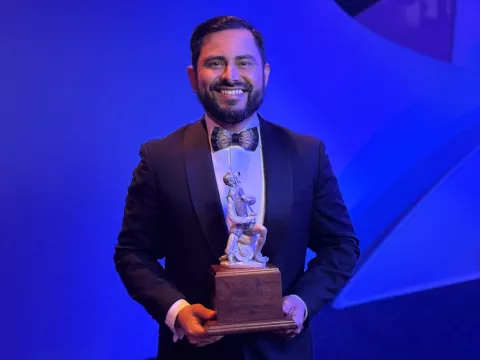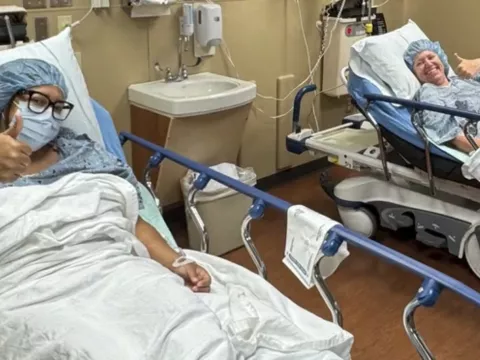- Jennifer Roberts
Choose the health content that’s right for you, and get it delivered right in your inbox.
Dana Callan is a family man with a successful business, constructing commercial canopies for large buildings. He’s always considered himself healthy, never needing to be on any prescription drugs.
But one day in September 2021, Callan didn’t feel like his energetic self. He was experiencing shortness of breath, and his heartbeat was off. It was enough of a warning to go to the emergency room at AdventHealth Altamonte Springs.
“I went in quickly, and they did some tests,” explains Callan. “The results that came back were very concerning. I had two pulmonary embolisms – they were clots very close to my heart and lungs.”
That night, Callan spoke on the phone with Dr. Rohit Bhatheja, an interventional cardiologist who would perform the life-saving procedure to remove those clots.

“If clots of this type are left untreated, they can get larger and cause significant stress on the heart and the lungs,” Bhatheja said. “The death rate can be 65-85% with these types of embolisms when the patient’s blood pressure drops. The clot doesn’t even have to burst to be dangerous. The heart will stop if the blood pressure changes too drastically – this is one of the causes of sudden cardiac death.”
“Dr. Bhatheja really reassured me that this was a safe and necessary procedure,” said Callan. “He answered all my questions and made me comfortable and ready to move forward.”
The following morning Callan was in an ambulance going to AdventHealth Orlando and was prepped to go into the Cardiac Catheterization Lab.
While Callan was awake, under no general aesthesia, Dr. Bhatheja performed a procedure to remove the clots. He inserted a thin spaghetti-like catheter through Callan’s groin and threaded it all the way to the clots near his lungs and heart.
“When the catheter reaches the clot, we can inject a very low dose of clot-busting medication directly into the clot,” explains Bhatheja. “The medication is strong and can’t be given as an IV because it would travel all over the body.”
Using a minimally invasive procedure that injects a small amount of medication directly into the clot, the clot dissolves and reduces the pressure on the heart and lungs, bringing it back to normal.
“I was awake the entire time,” recalls Callan. “I was able to watch the monitors during the procedure and see Dr. Bhatheja move the catheter. I marveled at the technology. It was so cool. I just kept shaking my head.”
Callan knows he was fortunate. He heeded the warning signs of tiredness and shortness of breath and got treatment quickly. Two weeks after his procedure, he was back at work.
“I consider myself very lucky to have been aware of warning signs and get to the hospital,” says Callan. “If I did the macho thing saying ‘oh, I’ll be fine’ – I might not be here today.”
Recent News
The Inspiring Wholeness podcast explains how to start an exercise routine, stay motivated and build endurance safely, to find your inner Ironman.
As the world rang in 2025, AdventHealth for Women welcomed the very first babies of the new year.
Dr. Joseph Lopez, chief of pediatric head and neck surgery at AdventHealth for Children, was honored with the prestigious Professional of the Year Award at the 27th Annual Don Quijote Awards.
Giving back to his hometown, Dr. Ryan Day brings advanced robotic surgery to local patients, offering life-saving care close to home.
The holiday season can increase heart attack risks due to overindulgence, stress, and ignored symptoms, but Dr. Hector Lozano advises moderation, staying active, managing stress, and sticking to...
Transplant is AdventHealth Transplant Institute’s 5000th kidney transplant
Deputies from local fire and police departments dressed as elves and dropped in to visit patients as part of an eight-year long tradition bringing festive cheer to kids and families staying at the...
AdventHealth is now using a fluorescent dye that lights up cancer cells during surgery, which is providing faster, more accurate treatment for patients.
On the newest Inspiring Wholeness podcast, Obie Diaz, local morning radio show host, shares how a routine physical eventually led to two open heart surgeries.
Inspired to change statistics around Black maternal deaths, AdventHealth for Women's Fourth Trimester Program offers enhanced postpartum care for Black mothers with high blood pressure.
AdventHealth University and Jobs Partnership Build Health Care Workforce Pipeline from Underserved Communities.
New LifeWorks Program provides health care workforce training to under-skilled job seekers throughout Central Florida.











